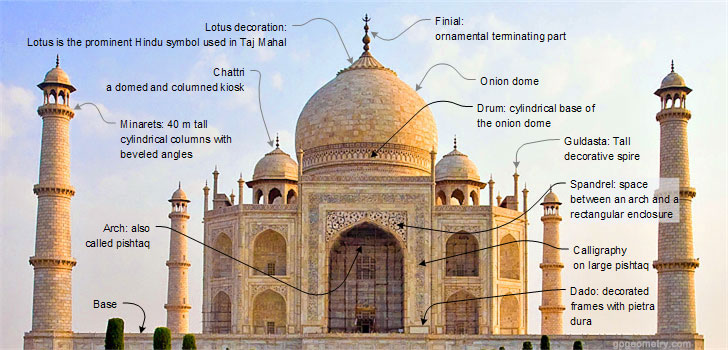|

The Taj Mahal is an architectural masterpiece
located in Agra, India, and is widely considered to
be one of the most beautiful buildings in the world.
The construction of the Taj Mahal involved a great
deal of geometry and mathematical calculations,
which helped to ensure that the building was both
structurally sound and aesthetically pleasing.
Some of the ways in which geometry was used in
the construction of the Taj Mahal include:
Symmetry: The Taj Mahal is a
symmetrical building, with the central dome,
minarets, and other elements arranged symmetrically
around a central axis. The use of symmetry helps to
create a sense of balance and harmony in the design.
Proportions: The proportions of
the Taj Mahal are carefully calculated to create a
sense of visual harmony. For example, the height of
the dome is exactly equal to the width of the
building, while the height of the minarets is
precisely one-quarter the height of the dome.
Angles: The angles of the walls
and other architectural features of the Taj Mahal
were carefully calculated to ensure that they would
be able to withstand the forces of gravity and other
external forces.
Curves: The Taj Mahal features
many curved elements, including the dome, arches,
and other decorative elements. These curves were
carefully calculated and designed to create a sense
of fluidity and grace in the building's design.
Overall, the use of geometry played a crucial
role in the construction of the Taj Mahal, helping
to create a building that is not only beautiful but
also structurally sound and durable.
The Taj Mahal is considered the finest example of Mughal architecture, a style that combines elements from Persian, Indian, and Islamic architectural styles.
In 1983, the Taj Mahal became a UNESCO World Heritage Site and was cited as "the jewel of Muslim art in India and one of the universally admired masterpieces of the world's heritage."
The Taj Mahal: Through the Lens of iPad & Apple Intelligence

See also:
Etching of the Taj Mahal
Jigsaw Puzzle:
the Taj Mahal and Geometry Shapes
|